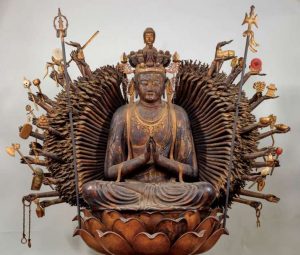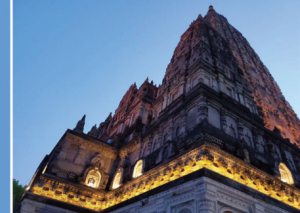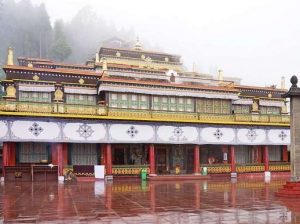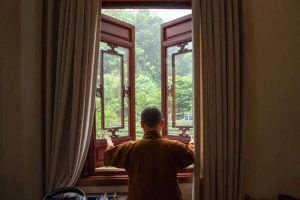In the early afternoon of 20 September 2017, seven volunteers from the Sakya Rinchen Ling Centre went for the first time to the women’s penitentiary in Obrajes Prison in La Paz, Bolivia, to provide training for a meditation course. It has been four years since that day.
The site is a ramshackle house guarded by the Bolivian police. The entrance is a small area and registration and body checks are both detailed and thorough. There is almost always a long queue that starts at the gates to the facility and stretches for several meters—mainly relatives and families who want to see their loved ones, for whom they bring food and clothing.

Because of the permission we received to teach the course, our access was a bit faster—our group of volunteers has training equipment and supplies, which they inspect one by one before each session. We were assigned Wednesday afternoons for the training.
We finally found the right building. The doors opened and the first thing we saw was a courtyard flooded with sunlight, and then the women deprived of their freedom. Several tables were laid out where the women gathered in little groups. They were listening to loud music and singing in a tumultuous cacophony. We could hear excited shouting from a football match on a nearby pitch. Other women we could not see told us they were taking other courses, primarily on artisan crafts. These women were not satisfied.
Amid the echoing noise of the talking, the music, and the football game, we entered a chapel in the middle of the main courtyard. The inside was clean and organized, with rays of light shining through the colorful windows and pretty flowers and plants livening up the room. The pews were lined up in organized rows. The orderly and cheerful ambience somehow seemed to make the background noise fade away. The chapel was the site assigned for our training classes. Given news of our arrival, the guards headed off to look for the women who had signed up for the course.

With the passing of time, more experienced meditators would return, along with newly incarcerated women who wanted to try a new experience. We set the mood by arranging the benches and a projector for screening the session and practicing meditation.
While the activities for these sessions have been carried out in the chapel, we have had the unconditional support of Sister Fideliza, who is in charge of the little religious refuge. From the beginning, when we explained our project to her, Sister Fideliza was extremely pleased. She said that contemplation is also an essential part of her tradition and that she would be happy for the inmates to practice. She meditated alongside us during many of the sessions, and her warm presence cheers up the space as she is a generous and good person. She took charge of women who lacked resources for personal or legal support like a mother caring for her daughters. Each and every day she tirelessly handles activities in the chapel and provides administrative support in the courtrooms.

We started the session. Brave women who were seeking change in their lives because they were not satisfied with them wandered in. They have experienced everything possible on the outside—some defeated by the weight crushing them—and were looking for a path that could lead them to a transformative experience.
The session began with a presentation. The women were exhausted by the distance of their loved ones: mothers who could not see their children, foreigners who felt like outsiders, women who thought being imprisoned was limiting their bodies and minds, difficulties getting along with other women with different habits and customs, competing for a position that would make them stand out in prison, and those without resources to better manage their freedom once outside. Defeated by the weight of their torments, some of them had resigned themselves and were passively present, barely there.
Many of them realize that they would be in a different situation if they had taken a different paths in life. Some lived in poverty and were abused by caretakers, doing whatever was necessary to survive. Others explained that bad company led them astray, while others had partners who took advantage of them. The stories showed us that they had not experienced peace in their lives. We ask them: “What do you know about meditation?” Most of them thought it was a kind of relaxation therapy.

We started by practicing mindfulness and asked participants to walk around the courtyard. When they returned to their places, we asked them about their experiences. Many said that it was nothing out of the ordinary, they were simply walking. For the second experience, we asked them to feel the movement of their bodies, how their feet support them on the ground, the weight of their bodies, and observing their breath and everything around them. When they returned this time, they were surprised because they noticed objects they had never seen before, that their bodies had a rhythm, and that their breathing was always present . . . the experience was like discovering something that had been hidden.
We began our explanation: they should understand that their state of mind is controlled by their thoughts and that actions are actually an automatic response to habits and customs created in the past. They could view the outcome of their actions like a wild horse without reins, and under such conditions, there is no control over their lives or their actions. Meditation can enable them to take hold of the reins on this wild and untamed horse. Then they can decide with a calm mind where they want to be, what is truly the most suitable place, and the direction in which they want to go.

This is a huge goal because before we can master our minds, we must first calm and control our bodies. The body is the vehicle that lets us access our minds. If the body is out of control, it is extremely difficult to approach our minds. Therefore, the first step is to work on behavior. We start by being mindful of our actions. We start with kindness, as we can all muster a smile for others who are seeking happiness, just like we are. Everyone is seeking happiness, even little insects that we can barely see. As the great master and philosopher Shantideva said: “Our happiness comes from making others happy and our suffering comes from wanting to seek our own happiness.” The great secret underlies these words. We thus began by assigning their first task: to give others a big smile.
We followed this with yoga to relax the body. However, due to the venue we could not sit in the lotus posture, which is ideal, and instead we practiced sitting down. We pointed out: “A straight back is very important for good meditation practice.”
At first it was very difficult for the women to get comfortable sitting in the correct posture. Some were overcome by lethargy, while others even fell asleep. Some, who were more distracted, kept looking around to see what was happening, although finally, some did follow the rhythm of the meditation. We explained that success in meditation is based on daily practice and that improvement and results are only effective with continuous practice.
The best ally in meditation is attention. We directed our attention to the object of our meditation, which is the breath. Breathing is our loyal friend because it is always with us. If we follow its flow, it will bring calm to stressful moments and transport us to a tranquil lake that causes our whole being to feel peace. We do not only meditate while in a session because we are always meditating: while we walk, while we sit; in every activity we can meditate. Accompanied by our friends—mindfulness and breathing—we will always be in good hands.

Time has passed, and by practicing meditation the woman have made changes. The sessions have progressed to more advanced content and many students have been extremely motivated. They saw that they could transform themselves and that anyone with true motivation and interest can achieve results.
We have had lovely experiences and we’ve learned that teachers can also learn from the details and experiences of their students. We ended up having a little party for the women at the end of one of the sessions. We gave them roses, cakes, and drinks. We very rarely realize how much happiness comes from the beauty of a flower, or that an act of attention creates sincere smiles and radiant faces. At the end, all the women left happy. This incredible adventure is bringing together people on the road and creating better conditions for their destinations. All beings can board the vehicle for liberation.
We would like to thank Lama Rinchen Gyaltsen from the Sakya Spain Foundation, for his constant support, teachings, and motivation. We hope he can continue to help more beings. This work would not have been possible without the dedication, enthusiasm and hard work of Rosselyn Tamayo, Jhory Montaño, Sonia Lizaraga, Marta Otazu, Mónica Ríos, and Liliana Arias, the women volunteers leading the meditation classes at Obrajes prison.
See more
Sakya Rinchen Ling – Bolivia (Facebook)
Related features from BDG
God of the Unknown: The Buddha in Chilean Magazines at the Turn of the 20th Century
Fo Guang Shan’s Never-ending Work in Chile
Growing Pains, Budding Flowers: The Hispanic Association of Buddhism
Dharma in Translation: Lhundup Damchö
The Tara Garden at Chagdud Gonpa Khadro Ling, Brazil
Un Buda – An Argentinian Vision of Buddhism












[…] Source: https://www.buddhistdoor.net/features/within-chaos-there-is-a-refuge-for-meditation/ […]